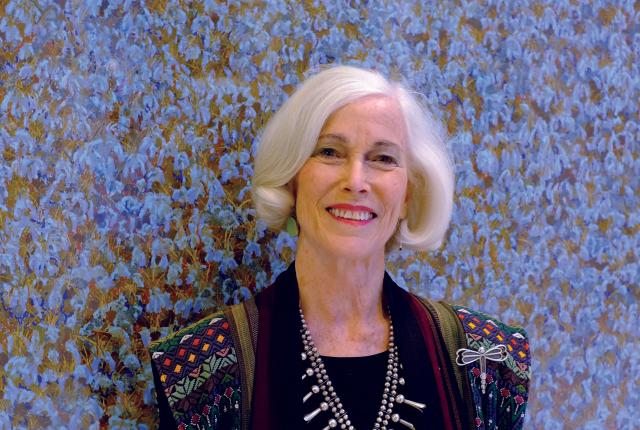Above: Paula Tackett. Photograph by John McCauley.
PAULA TACKETT REGULARLY STOPS VISITORS inside the Roundhouse, New Mexico’s capitol building, to say, “You’re in the best art gallery in the state.” Don’t argue with her. The building’s art curator, Cynthia Sanchez, calls Tackett “the mother of the collection.” As director of the Legislative Council Service, Tackett oversaw early efforts to acquire 14 artworks and 17 furniture groupings for the building’s 1991 renovation. That blossomed into a foundation that raised money for and accepted donations of hundreds of pieces—paintings, photographs, weavings, ceramics, sculptures—that bedeck nearly every wall of the building’s four floors, plus the annex hallway, North Capitol building, and surrounding grounds. The artists’ list includes historical standouts like San Ildefonso Pueblo potter Maria Martinez and contemporary masters like muralist Frederico Vigil. Tackett retired in 2010 but enjoys returning, partly to see the latest acquisitions.
One of the things I love is how it all got started. The initial idea was from Van Dorn Hooker, who said, “You should do a little art.” The Capitol Art Selection Committee began from that. We had 59 submissions for furniture, 200 submissions for art.
Van Dorn had been the University of New Mexico’s architect for 20 years and came to help us fix the electrical and mechanical systems. One day, he climbed up into the ceiling and, when he came down he said, “I think you have a bigger problem than you think.” Asbestos had gotten into the air-return plenum. We had to tear the building apart. We went from fixing some systems to a $32 million renovation.
We got beat up for it. There were a lot of articles written. Legislative leaders took the heat and agreed to spend the kind of money we needed to make this into a building that every New Mexican can be proud of.
The legislators had different feelings about the art. Some understood the importance of reflecting the heritage and culture of New Mexico through its art. And they all probably appreciated that kids would come up and be exposed to this. Nobody expected the traffic it would cause. That was a wonderful surprise. There’s something like 100,000 visitors a year.
Having the art here has affected how the legislators view art as an economic driver, to recognize it’s not just the extractive industries that fuel the state.
I didn’t think I liked modern art until a Larry Bell piece walked in one day. La Via del Hombre Blanco knocked my socks off. I don’t know why. It just hit me. It’s a mixed media on canvas. The light grabbed me and the textures. I was amazed.
Pablita Velarde’s The Buffalo Who Wouldn’t Die is a massive earth-pigment painting, maybe 12 feet long, that we’d had before the renovation. It had hung in the House Appropriations Committee room, where they had put a coffeepot underneath it. We had to take it down for the renovation, and it was so damaged that the New Mexico Museum of Art wasn’t going to let us have it back. But I begged them and promised to pay for the restoration.
The cowboy painting on the second floor, The Stranger’s Welcome, by Gary Niblett, was one of the first pieces donated to us. John Nieto gave us a triptych and three other pieces. Charlie Carrillo gave five santos. We set aside money, and James Rutherford, who had been curator of the Governor’s Gallery, went to the Crownpoint Rug Auction and bought Navajo rugs for the collection.
I wasn’t that schooled in art. I knew what I liked and even that has changed over time as I’m exposed to more things. At home, I have a lot of Native art—kachinas, little pots, fetishes. I love landscapes. I have lots of lithographs of buildings and a set of watercolors that a friend did for my retirement.
The legislature convenes a 30-day session on January 21. The building will be crammed. People can see government in action, and they can look at this amazing art. You can spend your whole day here.
The Capitol Café is open during sessions, too. They have a lot of good food. I always ate the grilled chicken sandwich, but the pies always looked really good, especially the pecan pie.

SEE FOR YOURSELF
Tours of the building are conducted from 8 a.m. to 4 p.m. Monday through Friday. Arrange a tour of the art by calling (505) 986-4614.


